“To die of heat” is not just a hyperbolic expression. With climate change and rising temperatures, heatwaves are becoming more and more frequent, and more and more deadly. But at what temperature do we really consider that the body is likely to succumb to the heat?
Humidity, a key factor
The human body's ability to withstand heat relies primarily on its ability to sweat. It is sweat that allows excess body heat to escape. However, the more humid the air, the less perspiration evaporates, and the less the body is able to cool itself. This is where the concept of “wet-bulb temperature” (wb) comes in, combining temperature and humidity to measure the actual risk of heat stress.
Wet-bulb thermometer
Wet-bulb temperature is a measurement that combines the heat and humidity of the air: the tip of the thermometer is wrapped in a wet cloth and the temperature is observed to drop, as evaporating water lowers the temperature. The drier the air, the lower the temperature; the more humid the air, the less it drops. This measurement is used to determine whether our body can cool itself by sweating: when it is very hot and humid, the body can no longer cool itself, which can become dangerous.
A temperature of 35°C wb is considered the absolute limit of human tolerance. Beyond that, even a young, healthy person can no longer dissipate heat. Their body temperature will then rise, leading to fatal hyperthermia within a few hours. In very dry conditions, humans can briefly survive extreme temperatures (up to 70°C), but as soon as humidity rises, the risk increases drastically.
Populations more vulnerable than others
While the wet-bulb threshold of 35°C is universal, vulnerability varies widely between individuals: the elderly, infants, pregnant women, the chronically ill, or those living alone are particularly exposed, as are workers exposed to heat and outdoor athletes. When the body can no longer cool itself, the internal temperature rises rapidly. Above 40°C, the risk of organ failure and death is significant.
In France, critical thresholds are rarely reached, but excess mortality during heatwaves is very real. As soon as temperatures exceed 30 to 35°C for several days in a row, the risk increases, especially if the humidity is high or if the nights do not allow the body to cool down. It is estimated that around 400 deaths per year in Paris are directly linked to the heat.
The right reflexes to protect yourself
When faced with heat, the right reflexes:
- Hydrate regularly
- Avoid physical exertion during the hottest hours
- Cool down (warm showers, air-conditioned rooms)
- Take care of vulnerable people around you



0 Comments